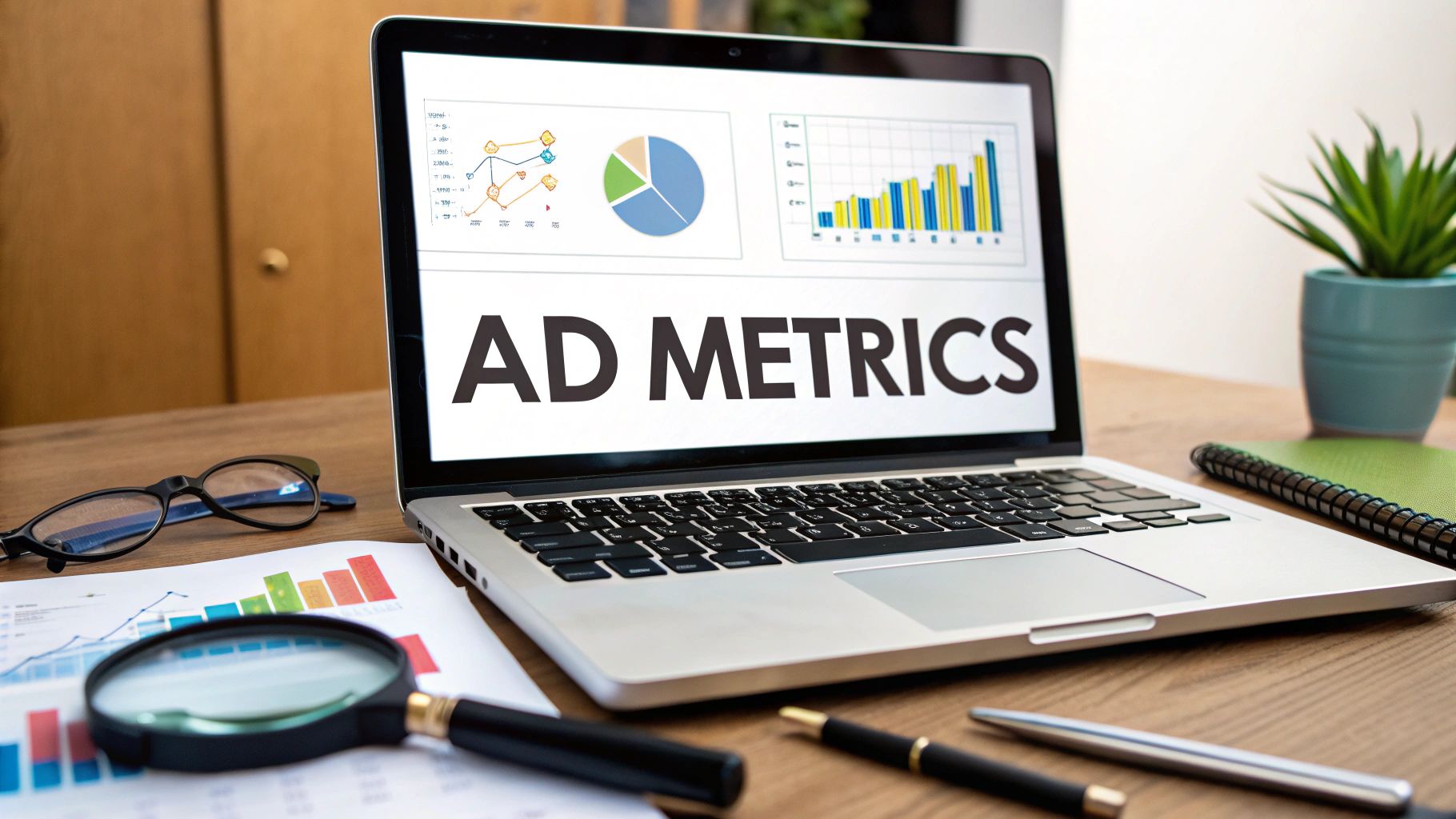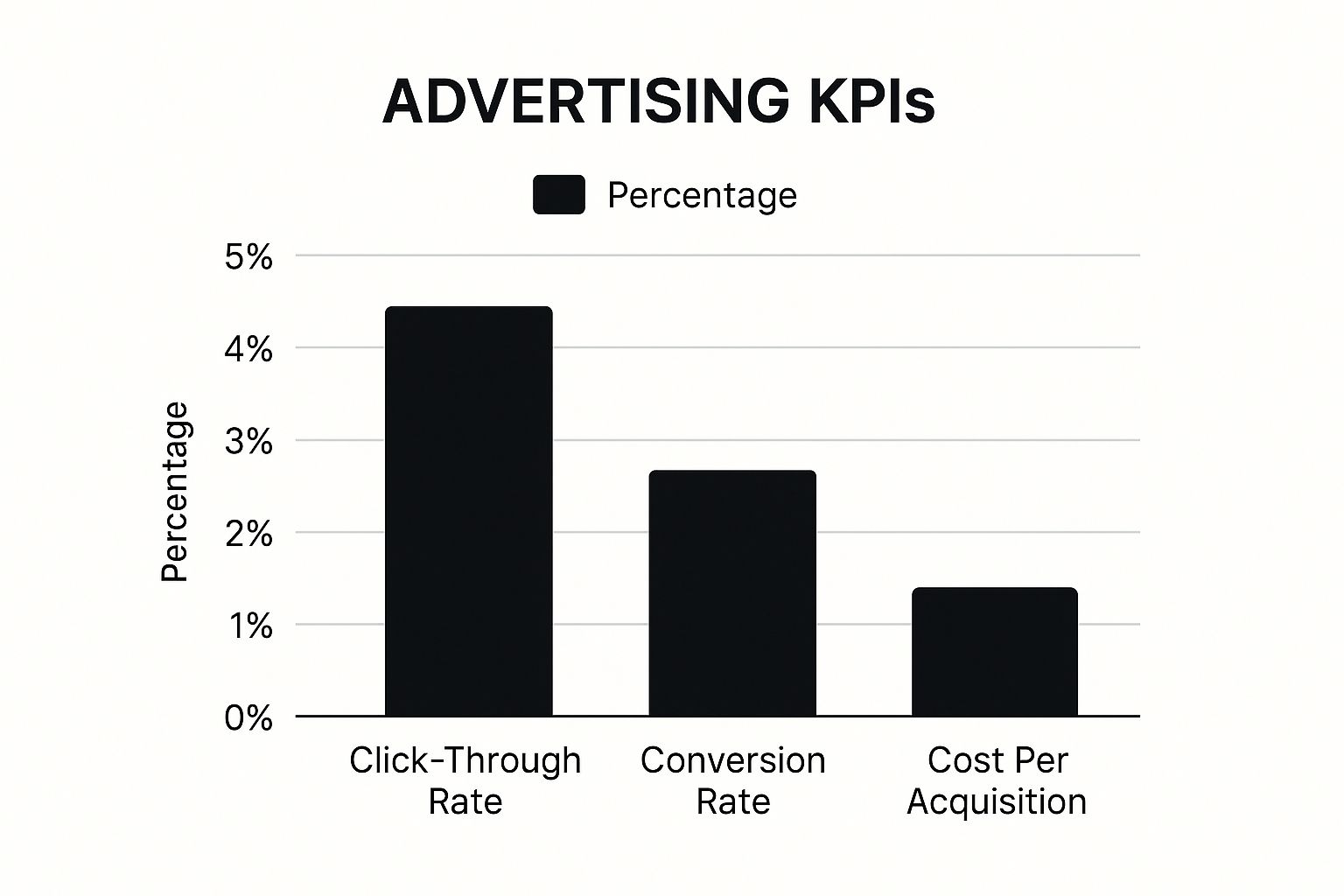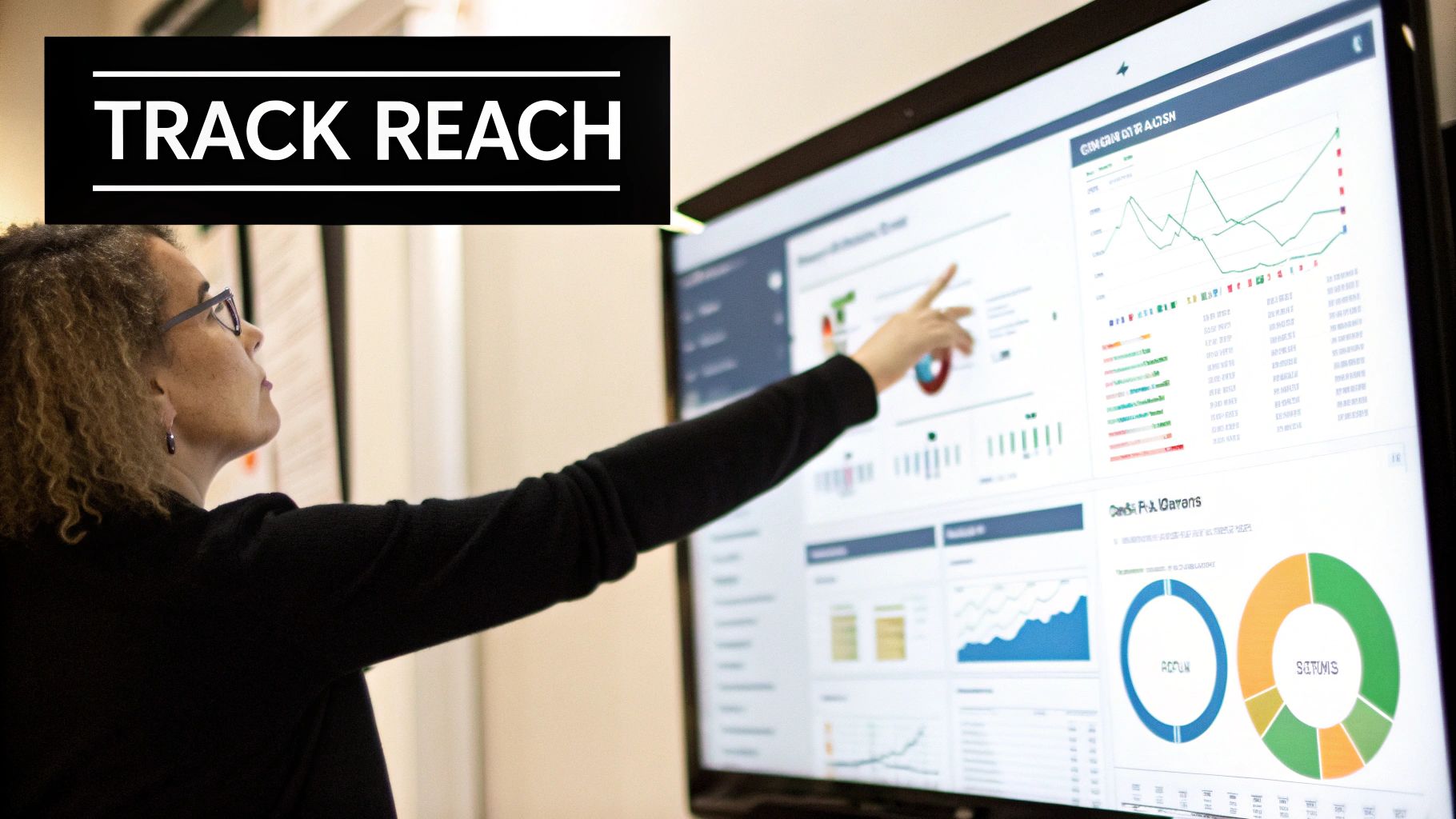August 25, 2025
How to Measure Advertising Effectiveness: A Clear Guide


Are your ads actually working, or are you just burning through your budget? It’s the question that keeps marketers up at night. Pouring money into campaigns without a clear way to see what's happening is like flying blind—sure, you're moving, but you have no idea if you're headed in the right direction.
Effective measurement isn’t about chasing vanity metrics; it's about connecting your ad spend directly to tangible business outcomes. Every dollar needs a purpose, and every campaign needs a goal.
This is where having a solid framework comes into play. If you really want to understand your ad performance, you have to start by actively measuring the success of your lead generation campaigns.
What Does "Success" Look Like for You?
Before you can measure anything, you have to decide what "effective" even means for your business. The answer is different for everyone.
Are you trying to get more eyeballs on a brand-new product? Or are you focused on driving immediate sales from a specific offer? The metrics you need to watch are completely different depending on your objective. A campaign built for brand awareness will look like a failure if you only judge it by sales, and vice-versa.
This graphic gives a great overview of some of the most critical KPIs you’ll run into.

As you can see, a high click-through rate is a good start, but a strong conversion rate is what actually grows the business and proves your ads are making a real impact.
Match Your Metrics to Your Mission
The key to measuring ad effectiveness is picking the right KPIs that line up with what you’re trying to accomplish. To make this easier, I've put together a quick-glance table to help you connect common campaign goals with the metrics that matter most.
Match Your Goal to the Right Metric
This table is a starting point, but it illustrates a crucial concept. For a lead generation campaign, your North Star is Cost Per Lead (CPL). For a brand play, you're probably more focused on video views or reach.
The core principle is simple: Your data should answer your most important business questions. If your goal is sales, but you're only tracking likes and shares, you're missing the entire story.
Choosing the Right KPIs for Your Campaign Goals

Okay, you’ve got your goals locked in. Now comes the fun part: picking the right Key Performance Indicators (KPIs) to see if you're actually hitting them. It’s incredibly easy to get swamped by all the data your ad platforms throw at you, but the real trick is to zero in on the numbers that actually matter for your specific objective.
A lot of marketers fall into the trap of chasing vanity metrics. These are the numbers that look great on a slide deck—things like social media likes, a sudden spike in followers, or a massive number of impressions. They feel good, but they don't necessarily put money in the bank.
Instead, you want to focus on action metrics. These are the KPIs that track behaviors directly linked to revenue and growth. We're talking about things like actual conversions, qualified leads, and, of course, sales.
Tying KPIs to Specific Goals
The KPIs you track should be a direct reflection of what you're trying to accomplish. There's no magic, universal dashboard here. A B2B company selling high-ticket software is going to care about completely different metrics than a Shopify store selling t-shirts.
Let's break down how this looks in the real world with a few common goals:
Goal: Brand Awareness
When you just want to get your name out there, your focus is on visibility. You want eyeballs—the right eyeballs. The KPIs you'll want to watch are Reach (the number of unique people who saw your ad) and Ad Recall Lift (the percentage of people who can actually remember seeing your ad after the fact).Goal: Lead Generation
Here, your mission is to fill the sales pipeline. The metrics that count are Cost Per Lead (CPL), which tells you exactly how much you're paying for each new prospect, and your Lead-to-Customer Conversion Rate. That second one is crucial because it shows you the quality of the leads you're generating.Goal: Direct Sales
For any e-commerce business, it’s all about the bottom line. You'll be living and breathing by your Return on Ad Spend (ROAS) and Customer Acquisition Cost (CAC). These two numbers cut through the noise and tell you, point-blank, whether your ad campaigns are making you money or costing you money.
My best advice? Don't measure everything; measure what matters. A clean, focused dashboard with three to five core KPIs that align directly with your main goal will give you a much clearer picture of your performance than a cluttered report filled with dozens of metrics that don't move the needle.
Laying a Solid Foundation for Ad Tracking

Before you can measure anything, your tracking setup has to be rock-solid. I can't stress this enough. If your foundation is cracked and the data you’re collecting is unreliable, any analysis you do will be completely useless. It's the classic "garbage in, garbage out" problem.
Think of your tracking setup like the plumbing for your marketing data. It needs to capture the entire customer journey—from the very first ad click all the way to the final purchase—without any leaks. This means getting a few technical pieces right from the start.
The Tracking Tools You Can’t Live Without
Building this data pipeline isn't nearly as complicated as it sounds. It really just comes down to a few key components that work together to give you a clear, accurate picture of what people are doing.
Here's what your essential toolkit should include:
- UTM Parameters: These are just simple tags you add to the end of your URLs. They tell your analytics platform exactly where your traffic came from—like a specific Facebook ad or an email newsletter—giving you crystal-clear source attribution.
- Tracking Pixels: I like to think of these as tiny spies on your website. Code snippets like the Meta Pixel or TikTok Pixel monitor user actions, connecting what people do on your site back to the ads they saw on social media.
- Conversion Events: This is where you tell your analytics tool what a "win" actually is. Setting up goals in Google Analytics, for instance, tells it to flag specific actions like a form submission or a completed purchase.
Getting these pieces configured correctly is absolutely non-negotiable. And if you ever run into hiccups, which happens to everyone, this resource on troubleshooting Google Ads conversion tracking issues can be a real lifesaver.
The old ways of measuring ad effectiveness are fading. Today, it’s all about real-time tracking that captures consumer responses the moment they happen. This shift lets you follow the journey from a social media feed directly to a shopping cart, giving you immediate, actionable feedback on what’s working.
Attribution Models That Actually Make Sense for Your Business
Ever get that nagging feeling you don't really know which ad led to a sale? Was it that first blog post someone found on Google? The Facebook ad they scrolled past last week? Or the final branded search ad they clicked right before buying?
This is the exact puzzle that attribution modeling is designed to solve. It’s all about creating a set of rules to figure out how to assign credit for a conversion across all the different touchpoints a customer interacts with. Getting this right is a total game-changer for understanding what's truly working.
The Go-To Attribution Models You Should Know
Here’s the thing: there's no single "best" model. The right one for you completely depends on your business. An e-commerce store selling t-shirts has a much shorter, simpler customer journey than a B2B software company with a six-month sales cycle.
Let's break down the most common options you'll run into.
Last-Click Attribution: This one’s the old classic. It gives 100% of the credit to the very last thing a customer clicked before they converted. It’s super simple to track, but its major flaw is that it completely ignores all the earlier marketing efforts that introduced the person to your brand in the first place.
First-Click Attribution: As you can probably guess, this is the polar opposite. The very first interaction gets all the credit. I find this model useful for understanding which channels are a great starting point for the customer journey, but it tells you nothing about what sealed the deal.
Choosing the right attribution model is all about finding the right balance for your business. Last-click is just too simplistic for most modern buying journeys. To get a real, holistic picture of your marketing ROI, you have to look a bit deeper.
Thinking Beyond Single-Touch Models
For most of us, the path a customer takes is rarely a straight line. They bounce around. That’s why multi-touch attribution models were created—they give you a much more nuanced view by splitting the credit across several different interactions.
Here are a few you'll see a lot:
Linear Attribution: This model is the diplomat—it spreads credit evenly across every single touchpoint. It’s fair, I guess, but it also means a fleeting glance at a social media ad is valued just as much as an in-depth product demo.
Time-Decay Attribution: This one feels more intuitive. The touchpoints closest in time to the final conversion get the most credit. This makes a lot of sense, because the ads someone sees right before they decide to buy are often the most persuasive.
Position-Based (U-Shaped) Attribution: This is a fantastic hybrid approach. It gives 40% of the credit to the first touchpoint (for introducing the customer) and another 40% to the last touchpoint (for closing the deal). The remaining 20% gets distributed evenly among all the interactions in the middle. It really values both the initial discovery and the final decision.
Alright, the data is flowing in. Now for the fun part. This is where you put on your detective hat and turn a pile of numbers into a clear roadmap for growth. Don't just stare at the dashboard; you need to find the story the data is telling you.

The easiest way to start is by looking for the outliers. I'm talking about the highs and lows. Is one ad creative crushing it with a ridiculously high click-through rate? Is a specific audience segment converting for peanuts compared to the others? These anomalies are your breadcrumbs, leading you straight to optimization opportunities.
Just remember, a single metric rarely tells the whole story. A high CTR is fantastic, but if none of those clicks are turning into actual sales, it’s a classic vanity metric. The real magic happens when you connect the dots between all your key performance indicators.
Turning Insights Into Action
Once you've spotted a few interesting trends, it's time to do something about them. This is what separates successful advertisers from people just throwing money at a platform. Let's be honest, today's ad world is a bit of a maze, but it also gives us more data than we've ever had.
Here are a few practical ways to start optimizing your campaigns right now:
- A/B Test Everything: Seriously. Never assume you know what will work. Constantly pit different headlines, images, calls-to-action, and even entire landing pages against each other. I've seen tiny tweaks lead to massive wins.
- Refine Your Audience Targeting: If your data screams that 35-44 year-old women in Texas are your best customers, listen to it! Double down on that segment by giving it more budget and consider pausing the audiences that are just eating up your cash.
- Reallocate Your Budget: This is simple but so effective. Shift your ad spend away from the campaigns and channels that aren't pulling their weight and pour that fuel on your top performers. Don't be afraid to cut your losses.
The heart of great ad optimization is a simple, continuous feedback loop: analyze, tweak, and repeat. It’s not a one-off task. It's an ongoing process of refinement that will steadily improve your results over time.
Once you've analyzed the results, using the right conversion rate optimization tools can give your campaigns a serious boost. When you combine those tools with a solid grasp of your numbers, you can make confident, data-backed decisions that consistently drive a better return on your ad spend.
A Few Common Questions We Get About Measuring Ad Effectiveness
Diving into ad measurement can feel like opening a can of worms. It’s totally normal to hit a wall, especially when you're staring at a spreadsheet full of confusing data or trying to explain performance to your boss.
Let's clear the air and tackle some of the most common questions that come up.
"What if I can't track every single thing?"
First off, take a deep breath. It's okay.
With all the new privacy rules and the slow death of third-party cookies, tracking every single user's every single move is pretty much impossible now. The goal isn't perfect, microscopic tracking anymore. It's about looking at reliable, bigger-picture data to spot trends.
The key is to focus on what you can control. This means getting your house in order with solid UTMs, tracking pixels, and clearly defined conversion goals. These fundamentals still give you a powerful, directional sense of what’s working, even if a few individual data points go missing along the way.
Here's the good news: privacy and effective ad measurement can absolutely go hand-in-hand. The future is all about using aggregated data and smart modeling to see the big picture without peeking into anyone's personal browser history.
"How do I actually know if my ads are making money?"
This is the million-dollar question, right? It all boils down to one crucial metric: Return on Investment (ROI).
While things like Return on Ad Spend (ROAS) are great for a quick health check on a specific campaign, ROI tells you the whole story. It forces you to account for all your costs—not just what you paid for the ad clicks—to see if you're truly profitable.
To get the real answer, you have to connect the dots between your ad data and your company's financial data. Our guide on what is return on investment breaks down exactly how to do the math, giving you a clear "yes" or "no" on whether your ads are actually paying off.
"How often should I be checking my campaigns?"
The honest answer? It depends on the size and timeline of your campaign. But here’s a rhythm that I've found works well for most people:
- Daily: A quick 5-10 minute peek is perfect. You're just looking for red flags—a sudden jump in your cost-per-click, an ad that got rejected, that sort of thing.
- Weekly: This is when you put your analyst hat on. Dig into performance trends, see how your A/B tests are shaking out, and make smart adjustments to your budgets and targeting.
- Monthly/Quarterly: Time to zoom out. Look at the high-level strategy. Is this channel still the right one for us? What are our big moves for the next quarter?
Resist the urge to constantly fiddle with your campaigns every day. The ad platform algorithms need time to learn and do their thing. Give your campaigns some breathing room to collect enough data before you make any drastic changes.
Ready to stop guessing and start optimizing your Google Ads with confidence? keywordme gives you the tools to clean up wasted ad spend, find high-converting keywords, and manage your campaigns up to 10x faster. Start your free 7-day trial and see the difference for yourself.


.svg)